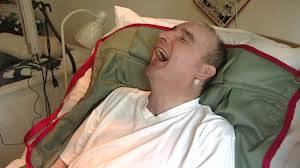Have you ever seen a person who is completely paralyzed and only using the eyes to communicate with others? It may be a case of Locked-in Syndrome (LIS) that he or she is suffering from. Read and know all about this disorder, including its varied causes, symptoms, diagnosis and measures adapted for its treatment.
Locked-in Syndrome Definition
Page Contents
- 1 Locked-in Syndrome Definition
- 2 Locked-in Syndrome ICD9 Code
- 3 Locked-in Syndrome History
- 4 Locked-in Syndrome Incidence
- 5 Locked-in Syndrome Types
- 6 Locked-in Syndrome Symptoms
- 7 Locked-in Syndrome Causes
- 8 What is Total Locked-in Syndrome?
- 9 Locked-in Syndrome Diagnosis
- 10 Locked-in Syndrome Differential Diagnosis
- 11 Locked-in Syndrome Treatment
- 12 Locked-in Syndrome Rehabilitation and Management
- 13 Locked-in Syndrome Prognosis
- 14 Locked-in Syndrome Complications
It is the name given to a disease in which a person suffers from a total paralysis of almost all the voluntary muscles in the body, apart from the eyes. Such a patient fails to communicate or move verbally, despite being wide awake and aware.
The condition affects the corticopontine, cortiocobulbar and corticospinal tracts of the body. It is also known by various other names, such as:
Picture 1 – Locked-in Syndrome
- Cerebromedullospinal disconnection
- De-efferented state
- Pseudocoma
- Ventral pontine Syndrome
Locked-in Syndrome ICD9 Code
The ICD9 Code of this condition is 344.81.
Locked-in Syndrome History
The name of this disorder was first coined in 1966 by two American neurologists – Jerome B. Posner and Fred Plum. The American Congress of Rehabilitation medicine, in the year 1995, defined this condition as a syndrome marked by the following features:
- Retention of awareness
- Ability to communicate while being voiceless and paralyzed
- Comparatively intact cognitive functions
As per this institution, the syndrome is defined by five criteria. These are:
- Preserved higher cortical functions
- Quadriparesis or Quadriplegia
- Blinking or vertical eye movements as primary means of communication
- Severe hypophonia or Aphonia
- Preserved vertical movement of eye and opening of eyes
Locked-in Syndrome Incidence
This is a very rare type of neurological disease that affects only a small percentage of the population. The actual figures about its prevalence are not known. However, the condition is believed to account for less than 1% of all cases of strokes.
Locked-in Syndrome Types
According to a classification, LIS can be categorized into the following three types:
Complete or Total LIS
It is marked by problems that are similar to those of anarthria and quadriplegia. Patients do not exhibit any movement of their eyes.
Classic LIS
In this type of the disorder, sufferers exhibit blinking and preserved vertical movement of eyes.
Incomplete LIS
In this form, patients recover some voluntary movements as well as the movements of their eyes.
In some cases, people affected by the classic form of LIS also recover some of the motor functions of one or more of the following regions of their body:
- Face
- Cervical spine
- Extremities of the limbs, most commonly the first foot digit or the thumb
People suffering from the incomplete form tend to have a more significant recovery. Problems in speech and swallowing generally show an improvement over a period of time. However, the voice continues to be somewhat dysarthric and weak. Such patients also regain better control of the motions of their trunk and head as well as partial function of at least one upper limb.
Locked-in Syndrome Symptoms
The disorder is characterized by severe defects arising due to the total disruption of the nerve pathways that control:
- Face
- Eyes
- Trunk
- Phonation
- Swallowing
- Respiration
- Movement of limbs
While cortical functions and consciousness are retained, communication is severely impaired. However, the muscles controlling the movement of the eyes are not harmed in any way. The patients remain mute, but are sometimes able to blink and move their eyes to convey their feelings.
Sufferers of this disease are able to think normally and have their reasoning powers intact.
The average age of onset of this syndrome tends to vary within 17 and 52 years. Youngest sufferers are found to have a better outcome, as far as survival is concerned.
Locked-in Syndrome Causes
The most common causative factors for this condition include:
- Medications
- Traumatic brain injury
- Ruptures of the aneurysm
- Stroke
- Infections
The condition may also result from an overdose of medications and demyelinating disorders (conditions which are characterized by a loss of insulating material surrounding the brain cells.
Generally, this disease occurs as a complication of a stroke or any other cerebrovascular accident in the basal region of the pons in the brainstem. In the majority of cases, the condition involves the ventral pons – the region of the brain that contains neural connections which allow voluntary movement.
Some other conditions, that are considered to be the underlying causes of this disease, include:
- Multiple Sclerosis
- Circulatory system disorders
- Lou Gehrig’s disease
- Brain hemorrhage
However, the condition most commonly arises from Ischemic strokes. These appear most frequently after a basilar artery thrombosis along with secondary occlusion of the perforating arteries.
What is Total Locked-in Syndrome?
It is a variation of LIS. In this form, patients lose even the ability to communicate with their eyes. They lose the power over their eyes and are considered to be completely paralyzed.
Locked-in Syndrome Diagnosis
The disorder leaves patients in a vegetative state. The case is not always diagnosed and reported as sufferers tend to die in the acute phase.
Physicians have to be extremely careful while detecting this condition due to the possibility of the symptoms being the result of any other disease that might be curable. The risk of misdiagnosis is high in this case. Due to this reason, healthcare providers have to strictly adhere to certain diagnostic guidelines. Locked-in Syndrome can be confirmed only when all the following diagnostic criteria have been met. These include:
- The cause of brain trauma should be established
- Medications or drugs are not responsible for the disorder
- 6 months or 12 months have passed after the occurrence a non-traumatic and a traumatic brain injury, respectively
- The curable problems within the metabolic system have not resulted in the signs of loss of awareness
- The possibility of curable factors, like a brain tumor, has been ruled out MRI and other brain imaging scans
- Medical professionals, such as physicians and nurses, have confirmed that the sufferer is in a persistent vegetative state and the fact is supported by friends and family members of the patient
- Two physicians, with necessary expertise in handling this condition, have confirmed independently that the patient has not exhibited any meaningful movement, awareness or attempt to communicate
In case there is a doubt in the diagnosis, a more expert assessment should be conducted by a psychiatrist and a neurologist.
Locked-in Syndrome Differential Diagnosis
During differential diagnosis, physicians should make sure that the paralysis is symptomatic of LIS and not of other conditions like
Locked-in Syndrome Treatment
Unfortunately, there is no treatment for this disorder. Certain paralyzed muscles may be activated through neuromuscular stimulation, which involves the use of electrodes to stimulate muscles. However, this type of treatment is only useful in rare cases. Most individuals affected by this syndrome fail to regain movement ever in their life. As such, treatment for this disease is usually supportive and symptomatic.
Locked-in Syndrome Rehabilitation and Management
Among all stroke survivors, patients with LIS are found to suffer from the highest level of disability. Due to this reason, an early diagnosis of this condition is essential for the purpose of rehabilitation. Participants need to be actively involved while making decisions about their rehabilitation. Rehabilitation involves:
Picture 2 – Locked-in Syndrome Image
Correction of Mobility and Positioning
It includes positioning the wheelchair or bed in such a way as to improve comfort and visual comfort of sufferers. Patients should be made to perform certain exercises to maintain their range of motion as well as control their limbs, head, eyes, trunk and breathing. Botox injections, antispasmodic drugs and stretching exercises can help reduce spasticity and improve the work of care providers, particularly in transfer, positioning and personal care for sufferers.
Cognitive rehabilitation
It involves improving the cognitive functions of sufferers. It is a challenge to both sufferers and healthcare providers, and is performed at the initial stages of the rehabilitation process. Physicians consider it appropriate to use psychostimulant medications when the condition creates problems in optimal outcomes for rehabilitation. In people with severe imbalance, serotonin reuptake inhibitors are viewed as the preferred mode of treatment.
Breathing and swallowing
Patients are initially fed through a feeding tube as the risk of aspiration is severely heightened in this disorder. Once the swallowing ability of sufferers has been clinically and radiologically assessed, the majority of sufferers gradually begin consuming thickened liquids and smooth purees. In some dysphagic patients, use of botox or scopolamine injections or anticholinergic medications at the parotid gland level helps in better control of saliva.
Communication
Patients are taught a system of reliable codes comprising of “yes” and “no” to help them communicate effectively. Initially, a few patients use blinking and eye movements for communication. Specialized language communication may be taught at a later stage.
Sphincter function control
It is aimed at training patients how to exercise control over their sphincter muscles and have continence. However, in case of severe paresis healthcare professionals opt for the use of indwelling catheters. These allow more freedom for moving about for sufferers.
Locked-in Syndrome Prognosis
Due to the absence of a standard treatment procedure, this condition has a poor outcome. Most patients fail to regain their function. Various devices are available, that help facilitate communication. It is only in rare circumstances that sufferers are found to regain any motor function. 90% of patients are found to die within 4 months after the onset of the condition although some sufferers are observed to live longer.
Locked-in Syndrome Complications
In the acute stages, infections (Pneumonia in most cases) are the most common cause of the death of sufferers. Death occurs in 40% of all cases of acute stage LIS. In 25% of all cases, the primary cause of death is initial stroke.
As aforesaid, Locked-in Syndrome is an extremely paralyzing condition that even leads to the death of patients in severe cases. However, patients are found to have a better outcome and regain some of their motor functions with proper and early treatment. Due to this reason, family members of LIS sufferers should try their best to get adequate medical care. They should consult medical professionals and help them devise a proper treatment plan to bring about an improvement in the symptoms of their dear ones.
References:
http://www.nhs.uk/conditions/vegetative-state/pages/diagnosis.aspx
http://www.medterms.com/script/main/art.asp?articlekey=11024
http://cirrie.buffalo.edu/encyclopedia/en/article/303/
http://www.uptodate.com/contents/locked-in-syndrome
http://en.wikipedia.org/wiki/Locked-in_syndrome


